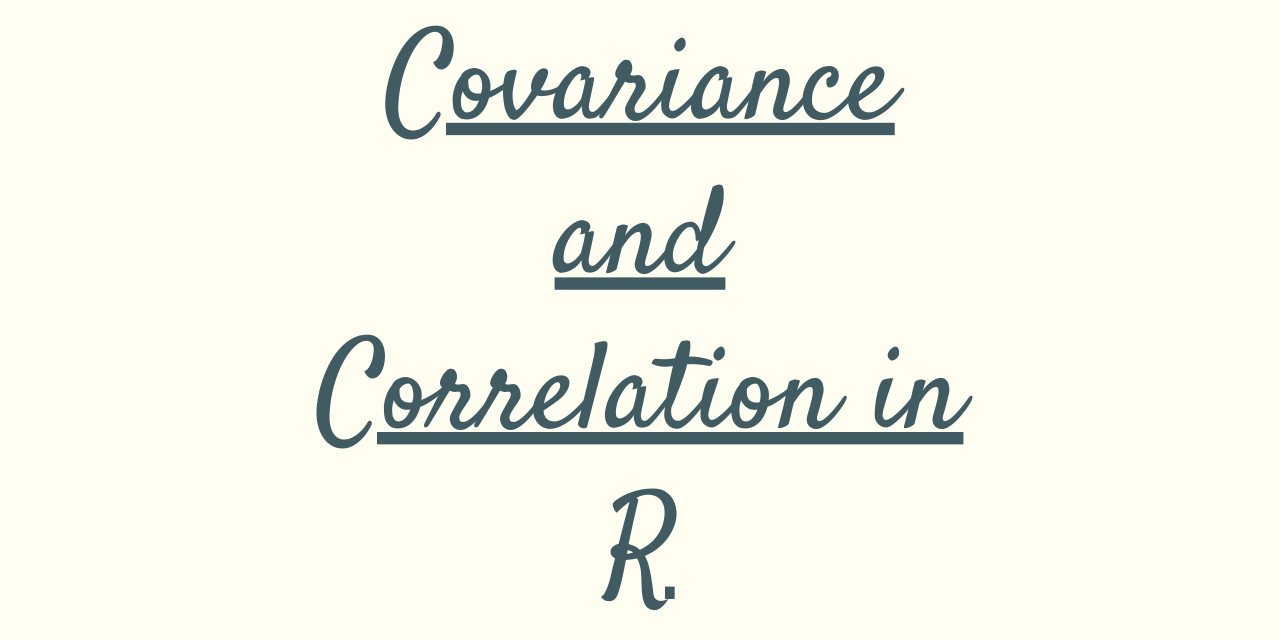- Log in to:
- Community
- DigitalOcean
- Sign up for:
- Community
- DigitalOcean
By Safa Mulani

Hello readers! In this article, we would be focusing on two important parameters of statistics – Covariance and Correlation in R programming, in detail.
So, let us begin!!
Covariance in R programming
In Statistics, Covariance is the measure of the relation between two variables of a dataset. That is, it depicts the way two variables are related to each other.
For an instance, when two variables are highly positively correlated, the variables move ahead in the same direction.
Covariance is useful in data pre-processing prior to modelling in the domain of data science and machine learning.
In R programming, we make use of cov() function to calculate the covariance between two data frames or vectors.
Example:
We provide the below three parameters to the cov() function–
- x – vector 1
- y – vector 2
- method – Any method to calculate the covariance such as Pearson, spearman. The default method is Pearson.
a <- c(2,4,6,8,10)
b <- c(1,11,3,33,5)
print(cov(a, b, method = "spearman"))
Output:
> print(cov(a, b, method = "spearman"))
[1] 1.25
Correlation in R programming
Correlation on a statistical basis is the method of finding the relationship between the variables in terms of the movement of the data. That is, it helps us analyze the effect of changes made in one variable over the other variable of the dataset.
When two variables are highly (positively) correlated, we say that the variables depict the same information and have the same effect on the other data variables of the dataset.
The cor() function in R enables us to calculate the correlation between the variables of the data set or vector.
Example:
a <- c(2,4,6,8,10)
b <- c(1,11,3,33,5)
corr = cor(a,b)
print(corr)
print(cor(a, b, method = "spearman"))
Output:
> print(corr)
[1] 0.3629504
> print(cor(a, b, method = "spearman"))
[1] 0.5
Covariance to Correlation in R
R provides us with cov2cor() function to convert the covariance value to correlation. It converts the covariance matrix into a correlation matrix of values.
Note: The vectors or values passed to build cov() needs to be a square matrix in this case!
Example:
Here, we have passed two vectors a and b such that they obey all the terms of a square matrix. Further, using cov2cor() function, we achieve a corresponding correlation matrix for every pair of the data values.
a <- c(2,4,6,8)
b <- c(1,11,3,33)
covar = cov(a,b)
print(covar)
res = cov2cor(covar)
print(res)
Output:
> covar = cov(a,b)
> print(covar)
[1] 29.33333
> print(res)
[,1] [,2] [,3]
[1,] 6000 21 1200
[2,] 5 32 2100
[3,] 12 500 3200
Conclusion
By this, we have come to the end of this topic. Here, we have understood about the in-built functions to calculate correlation and covariance in R. Moreover, we have even seen function in R that helps us translate a covariance value into a correlation data.
Feel free to comment below, in case you come across any question. For more such posts related to R, Stay tuned.
Till then, Happy Learning!! :)
Thanks for learning with the DigitalOcean Community. Check out our offerings for compute, storage, networking, and managed databases.
About the author
Still looking for an answer?
- Table of contents
- Covariance in R programming
- Correlation in R programming
- Covariance to Correlation in R
- Conclusion
Deploy on DigitalOcean
Click below to sign up for DigitalOcean's virtual machines, Databases, and AIML products.
Become a contributor for community
Get paid to write technical tutorials and select a tech-focused charity to receive a matching donation.
DigitalOcean Documentation
Full documentation for every DigitalOcean product.
Resources for startups and SMBs
The Wave has everything you need to know about building a business, from raising funding to marketing your product.
Get our newsletter
Stay up to date by signing up for DigitalOcean’s Infrastructure as a Newsletter.
New accounts only. By submitting your email you agree to our Privacy Policy
The developer cloud
Scale up as you grow — whether you're running one virtual machine or ten thousand.
Get started for free
Sign up and get $200 in credit for your first 60 days with DigitalOcean.*
*This promotional offer applies to new accounts only.
